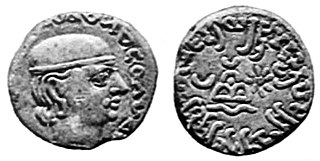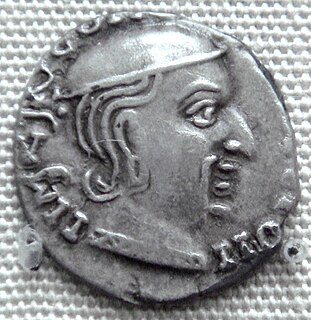
Strato II "Soter" was an Indo-Greek king. He ruled c. 25 BCE to 10 CE according to Bopearachchi. R. C. Senior suggests that his reign ended perhaps a decade earlier. He may have been supplanted by the Indo-Scythian Northern Satraps, particularly Rajuvula and Bhadayasa, whose coins were often copied on those of the last Indo-Greek kings. Numerous coins of Rajuvula have been found in company with the coins of the Strato group in the Eastern Punjab and also in the Mathura area: for example, 96 coins of Strato II were found in Mathura in conjunction with coins of Rajuvula, who also imitated the designs of Strato II in the majority of his issues.
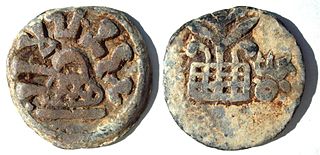
The Chutu dynasty ruled parts of the Deccan region of South India between first and third centuries CE, with its capital at Banavasi in present-day Karnataka state. The Chutus probably rose to power as Satavahanas feudatories, and assumed sovereignty after the decline of the Satavahana power. Except for the edicts of Asoka, the inscriptions of the Chutu dynasty are the oldest documents found in the northern part of Karnataka State, India
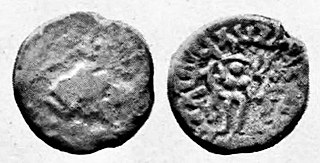
Sodasa was an Indo-Scythian Northern Satrap and ruler of Mathura during the later part of the 1st century BCE or the early part of 1st century CE. He was the son of the Great Satrap of Mathura Rajuvula. He is mentioned in the Mathura lion capital.
Gautamiputra Satakarni, also Gautamiputra Yajna Satakarni, was a ruler of the Satavahana Empire in present-day Deccan region of India. He ruled in the 2nd century CE, although his exact period uncertain. His reign is dated variously: 86-110 CE, c. 103-127 CE, or 106-130 CE.

Rudradaman I was a Saka ruler from the Western Kshatrapas dynasty. He was the grandson of the king Chastana. Rudradaman I was instrumental in the decline of the Satavahana Empire.

The Traikutakas were a dynasty of Indian kings who ruled between 388 and 456. The name "Traikutakas" seems to be derived from the words for a three-peaked mountain ("Tri-kuta"). The Traikutakas are mentioned in Kalidasa's Raghuvamsa, in which they are located in the area of northern Konkan. The dominions of the Traikutakas further included Aparanta and northern Maharashtra.

Yajna Sri Satakarni, also known as Gautamiputra Yajna Sri, was an Indian ruler of the Satavahana dynasty. His reign is dated variously: c. 152-181 CE, c. 165-195 CE, c. 170-199 CE or c. 174-203.

Rudrasimha III was the last ruler of the Western Satraps in India, in the 4th century.
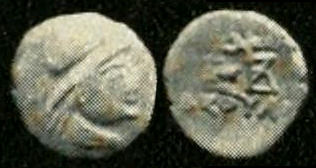
Liaka Kusulaka was an Indo-Scythian satrap of the area of Chukhsa in the northwestern South Asia during the 1st century BCE.

The legacy of the Indo-Greeks starts with the formal end of the Indo-Greek Kingdom from the 1st century CE, as the Greek communities of central Asia and northwestern India lived under the control of the Kushan branch of the Yuezhi, apart from a short-lived invasion of the Indo-Parthian Kingdom. The Kushans founded the Kushan Empire, which was to prosper for several centuries. In the south, the Greeks were under the rule of the Western Kshatrapas.

Rudrasimha I was a Western Kshatrapa ruler, who reigned from 178 to 197 CE. He was son of Rudradaman I, grandson of Jayadaman, and grand-grandson of Chashtana.
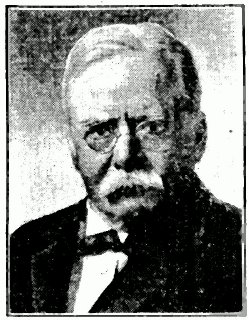
Edward James Rapson FBA was a British numismatist, philologist and professor of Sanskrit at the University of Cambridge. He was a fellow of St. John's College. Rapson died following a sudden collapse at dinner at St. John's.

Rudrasimha II (304–348) was a ruler of the Western Satraps He declared on his coins to be the son of a Lord (Svami) Jivadaman.

Yasodhaman II (317–332) was a son and probably sub-king of king Rudrasimha II of the Western Satraps He declared on his coins to be the son of Rudrasimha II.

Damasena was a Western Kshatrapa ruler, who reigned from 223 to 232 CE. From the reign of Rudrasimha I, the date of minting of each coin, reckoned in the Saka era, is usually written on the obverse behind the king's head in Brahmi numerals, allowing for a quite precise datation of the rule of each king. This is a rather uncommon case in Indian numismatics. Some, such as the numismat R.C Senior considered that these dates might correspond to the much earlier Azes era instead.
The British Museum Catalogues of Coins was a series envisioned and initiated by Reginald Stuart Poole, Keeper of the Department of Coins and Medals, at the British Museum, between 1870 and 1893. The aim was to produce a scholarly series of catalogues of the collection, based on the British Museum's collection and other collections. The series continued after his retirement, and continues to this day, with the collection increasingly being made available online.
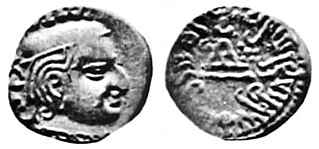
Damajadasri III was a ruler of the Western Satraps. His reign lasted possibly from c. 251 AD to 256 AD.


